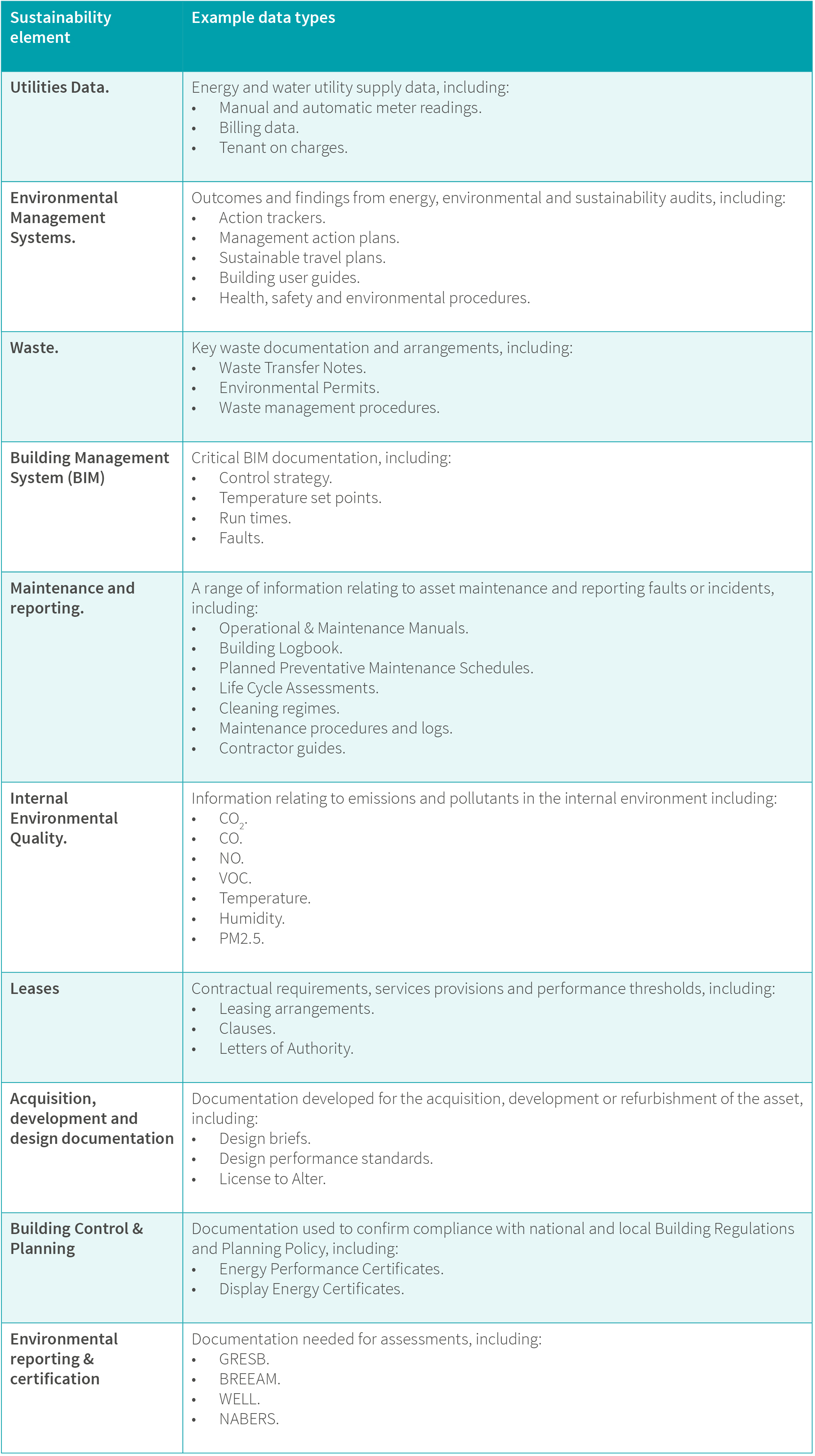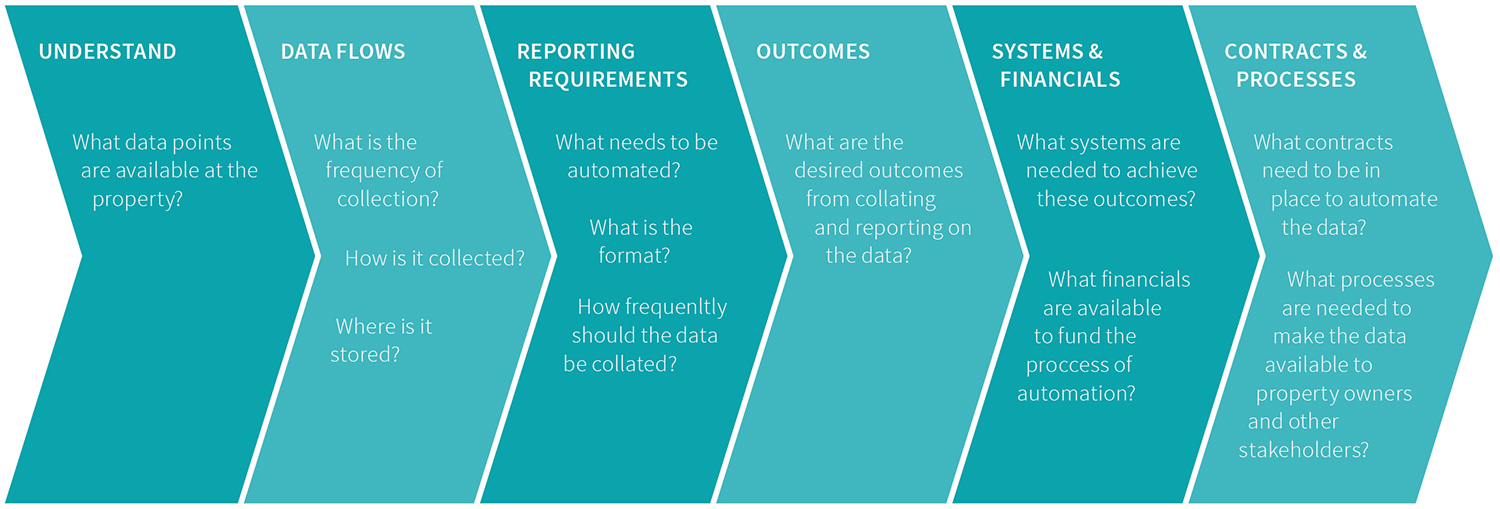GN 2.2: Automating property level data
Guidance Note purpose
The purpose of this Guidance Note is to provide asset managers, property managers and facilities managers with information about the automation of property level data in relation to sustainability.
Context
Technological advances have increased the extent to which data can be automated and used to support monitoring, management and reporting of a property’s sustainability credentials.
Alongside this enhanced capability, there is greater demand for automated sustainability data by the range of property stakeholders. This demand has arisen from, for example:
- The recognition of the importance of demonstrating the built environment’s contribution to managing the UK’s environment footprint and social wellbeing.
- The expansion of E.S.G. reporting, and associated certifications, ratings and benchmarks, increasing the demand for performance data, at increasing granularity of detail, and with associated verification.
- A desire to address the performance gap between the anticipated property ‘design performance’ and the actual ‘in-use performance’.
- The emergence of Building Information Modelling (BIM) to support the optimization of sustainability performance within building design and operation.
Importance
A number of potential benefits can result from increasing the automation of property level data. For example:
- Accountability. Asset managers and occupiers can use automated data to develop a better understanding of the impact a property may have upon their ESG or investment strategy.
- Optimisation. Automated data can enable an understanding of how a property is operating in real time. This can help to identify quick-win solutions, such as reducing equipment operational running times or better aligning a property to the requirements within the design standards or lease.
- Accessibility. Data is more accessible to a wider audience so that a wider range of stakeholders can interact with the property and its management, allowing greater collaboration and a broader range of improvement opportunities to be realised.
A number of potential lost opportunities can result from failing to increase the automation of property level data. For example:
- Missed opportunities. Opportunities for improvements or recognition, such as an environmental rating, can be missed because documents are not accessible.
- Continuation of the status quo. It can be difficult for stakeholders to engage with non-automated data, limiting their ability to influence or improve maintenance, monitoring and improvement regimes.
- Vacancy and redundancy. Limiting the ease in which property information can stay current with changes in regulation or occupier requirements.
Responsibilities & Interests
The table below summarises the key activities associated with automated property-level data, and highlights where asset managers, property managers and facilities managers are likely to have a responsibility or specific interest.
- AM - Asset Manager
- PM - Property Manager
- FM - Facilities Manager
Step 1: Review the role of property managers in facilitating automated data
Stakeholder:
Step 2: Consider the applicability of different automated data types
Stakeholder:
Step 3: Understand the process flow for automating property data
Stakeholder:
How to
Intro
Usually, the decision to invest in automated property level data is taken by an asset manager. The process of collecting and using property data is co-ordinated by a property manager within input from a range of property stakeholders.
The following elements should form part of considerations regarding the development of property-level data:
Step 1: Review the role of property managers in facilitating automated data
There are a range of important roles that a property manager can undertake in relation to automated property level data. These include, for example:
- Holder. A property manager can be the holder of the property level data, especially the data around the management practices.
- Identifier. A property manager can identify the data flows that are for automisation at the property or where data gaps are present.
- Facilitator. A property manager can facilitate the flow of data, ensuring the necessary stakeholders are engaged and the potential for optimisation and improvement is met.
- Implementor. A property manager can implement the actions that have come from the automisation of data, such as HVAC improvements, maintenance and monitoring regimes.
- Reviewer. A property manager can review the data flows, comparing and contrasting against trends to understand performance and identify areas for future consideration.
Step 2: Consider the applicability of different automated data types
It is important that asset, property and facilities managers invest time to review the different types of automated data that could be adopted for a property. There are a range of property data types that can benefit from automation, for example:

Step 3: Understand the process flow for automating property data
It is important that asset, property and facilities managers invest time to understand the process flow for automating property data.
This relates to taking an holistic and strategic approach to the use of data in managing the sustainability performance of a building, and considering how data is, and could potentially become, integrated into the property management operations and supply chain.
The process for automate data within a property, either for the first time or when reviewing existing practices, should consider the following elements:
Identify.
- What data points are available at the property?
Data flows.
- What is the frequency of data collection?
- How is data collected?
- Where is data stored?
Reporting requirements.
- What data needs to be automated?
- What is the data format?
- How frequently should the data be collated?
Outcomes.
- What are the desired outcomes from collating and reporting on the data?
Systems and financials.
- What systems are needed to achieve these outcomes?
- What financials are available to fund the process of data automation?
Contracts and processes.
- What contracts need to be in place to automate the data?
- What processes are needed to make the data available to property owners and other stakeholders?

Related Guidance Notes
The following Guidance Notes contain related information:
- GN2.1: An asset register
- GN2.3: Sustainability reporting
- GN2.5: Maintenance and monitoring
- GN4.4: Advanced metering
- GN4.5: Energy consumption profile
- GN4.12: Energy performance monitoring
- GN5.1: Leak inspections
- GN7.2: Electric vehicle charging facilities